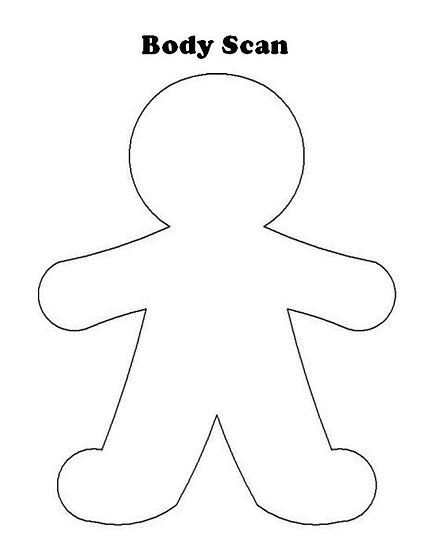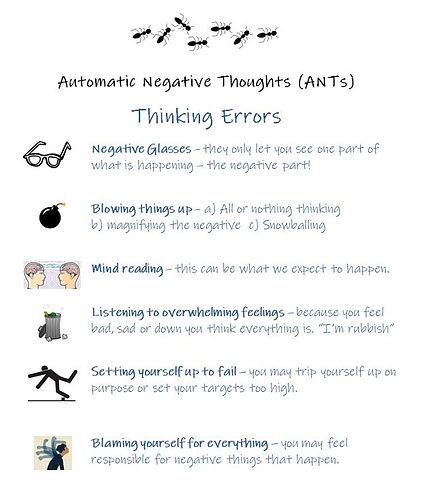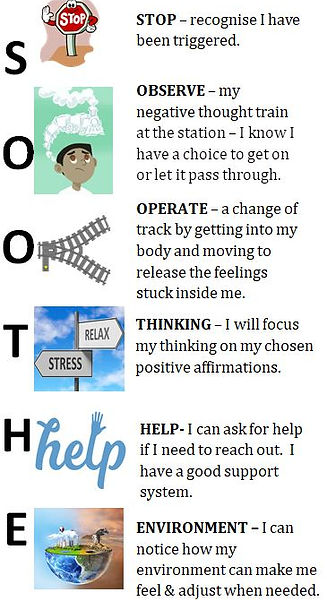Anxiety
Take a look at this image. For a moment imagine you are the caveman in the picture. You are face to face with a very hungry dinosaur - how do you survive?!
Most likely you will have answered with either:
-
FIGHT it off
-
RUN for your life
-
FREEZE and play dead
This is known as the FIGHT, FLIGHT or FREEZE response and is an automatic reaction for us humans when faced with a perceived threat.


BODY SCAN
Use this body scan worksheet to locate all the feelings you are sensing in your body right now. Draw on each feeling in the colour you sense it as and the shape it may feel inside.

Whilst we don't have hungry meat-eating dinosaurs roaming the earth today, we still have the same responses within the body when we perceive a fear or threat. This could be anything from an impending test at school or witnessing people arguing.
Do you ever notice any of the reactions illustrated here? This is an indication your body has triggered the stress response. This is part of your Autonomic Nervous system; the Sympathetic Nervous System (SNS) prepares you for fight, flight or freeze; whilst your Parasympathetic Nervous System (PNS) enables you to rest and digest.
Feeling anxious means your body is on high alert for danger. Automatic negative thoughts (ANTs) can trigger anxiety. Have a look at the image below and see if you have any of these ANTs in your mind? ANTs are what we call 'thinking errors', our brains sometimes go into overdrive when we can't make sense of a feeling.
When our minds are busy with lots of anxious thoughts and we have stressful feelings in our bodies, we may behave differently - this is called being 'dysregulated'. To be able to feel emotionally regulated we need to engage our body and mind. By sensing feelings in the body we can then use movement and breath, along with reframing our thoughts to regulate our feelings.


TOOL BOX
Here you can create your own toolbox of strategies that soothe your anxious thoughts.

WINDOW OF TOLERANCE
This image clearly illustrates the different states that affect you. Download the worksheets here to complete your own assessment of triggers for dysregulated states.
If you are supporting a child with their emotional regulation I have created the following resources to explore their triggers and how to work out a plan to soothe these using my SOOTHE plan.
DOWNLOAD your child's worksheets here:
Window of Tolerance graphic - MindmyPeelings

TRY OUT THESE STRATEGIES FOR YOUR TOOLKIT...
Solfeggio Frequencies:
Researchers have found that the frequency of 528 Hz specifically has the power to reduce stress and anxiety. Listen to the sounds here:

The Vagus Nerve:
Have you heard of the vagus nerve? Many people haven't - but it is has such an important role in maintaining our mental health and wellbeing, so it is essential we understand its function. The vagus nerve controls the entire parasympathetic nervous system, our “rest-and-digest” or “feed and breed” activities. Its name comes from the Latin ‘vagary’ which means wandering.
As you can see from the image here the nerve starts in the brainstem’s medulla, travels down the side of the neck, into the chest, then down into the stomach. It makes its way to many organs on its journey, including the heart, lungs, oesophagus, pancreas, and intestines.
The vagus nerve is a two-way communicator; it transmits signals throughout the body and then sends them back to the brain.
It regulates the immune response, hunger hormones and food intake, anxiety levels, and inflammation levels, so it plays an important role in the body in soothing the stress response.
You may have heard of the term creating 'vagal tone' which refers to the nerve’s activity; research shows that a high vagal tone improves the body’s ability to regulate blood glucose levels, reset the immune system and turn off inflammation - so creating vagal tone is so important for health and wellbeing.
Here are some ways you can create vagal tone:
1. Breath work - deep belly breaths in for 5 and slow exhale for 5 then repeat 5 times.
2. Chanting, singing, humming or gargling - the muscles of the vocal cords are connected to the vagus nerve.
3. Cold exposure - Cold showers are the easiest way to integrate this into your life. At the end of your shower, lower the temperature for 30 seconds of cold water. Or place your face in a bowl of iced water for 10-30 seconds and repeat 4-5 times.
4. Exercise - Movement is such a powerful way to improve your vagal tone, to be more connected, and to enhance your sense of happiness.
5. Meditation - regular practice can decrease your stress response, and improve your mindfulness awareness over time. Try out a short practice for adults here or children in the video below..

Tapping Technique: What is EFT Tapping?
A combination of Ancient Chinese Acupressure and Modern Psychology, Tapping quickly gets to the heart of the issue, working to rewire the brain, calm the amygdala, and create safety in the body to ease stress and release trauma.
Download resources and worksheets to support your child here.

Image: Tapping Solution Foundation

What is a panic attack?
Panic attacks are a type of fear response. During a panic attack, physical symptoms can build up very quickly. These can include:
-
a pounding or racing heartbeat
-
feeling faint, dizzy or light-headed
-
feeling very hot or very cold
-
sweating, trembling or shaking
-
feeling sick
-
pain in your chest or stomach
-
struggling to breathe or feeling like you're choking
-
feeling like your legs are shaky or are turning to jelly
-
feeling disconnected from your mind, body or surroundings, which are types of dissociation.
During a panic attack you might feel very afraid that you're:
-
losing control
-
going to faint
-
having a heart attack
-
going to die.
Often people will breath in and not expel air during a panic attack. Try the 4-7-8 breathing technique here to support someone having a panic attack. Remind them it will not last.





